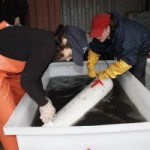
Northwest Indian Fisheries Commission, nwifc.org
Using fish from the Suquamish Tribe’s Grovers Creek hatchery, federal agencies and their partners are determining just how lethal polluted urban highway runoff is to salmon.
Staff from the U.S. Fish and Wildlife Service (USFWS) and the National Oceanic and Atmospheric Administration-Northwest Fisheries Science Center (NOAA) have been working with the tribe to expose a small number of adult coho spawners to polluted urban runoff.
“We know that toxic contaminants in stormwater are bad for salmon, and that adult coho are dying prematurely in urban watersheds throughout Puget Sound,” said Jay Davis, a USFWS contaminants specialist. “The current study is designed to help us determine the underlying cause of death.”Last year, agency scientists exposed adult coho to cocktails of chemical contaminants that were prepared in a lab to simulate stormwater runoff. The fish were largely unaffected by artificial mixtures of metals and petroleum hydrocarbons.
However, when exposed to actual urban runoff this fall, the spawners quickly developed the familiar symptoms of pre-spawn mortality syndrome. Symptoms include a gaping mouth, and loss of orientation and balance. Affected fish display these symptoms just before they die, and adult coho became symptomatic after just two to four hours of being exposed to the stormwater.
Blood and tissues were collected from the hearts, gills, and livers of the coho. Genetic analyses of these samples are expected to show physiological stress in fish, such as heart or respiratory failure. Samples from coho exposed to stormwater will be compared to samples from unexposed fish and symptomatic spawners found in Seattle-area streams this fall.
“Urban runoff is a very complex mixture,” Davis said. “But we’re getting closer to understanding why stormwater is so lethal to coho.”
“The tribe has been a good partner to work with,” said Nat Scholz, a NOAA research zoologist and ecotoxicology manager. “We like to use the Grovers Creek facility because of the easily available coho, the facility’s abrupt saltwater-freshwater transition, and the availability of protected space to do the exposures and tissue collections. The findings should be applicable throughout Puget Sound, including Kitsap.”
The contaminated water is taken for disposal to Kitsap County’s wastewater treatment plant in Kingston.
